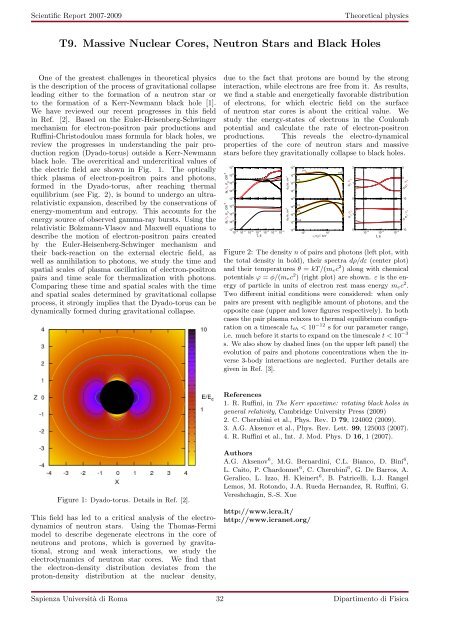download report - Sapienza
download report - Sapienza
download report - Sapienza
You also want an ePaper? Increase the reach of your titles
YUMPU automatically turns print PDFs into web optimized ePapers that Google loves.
Scientific Report 2007-2009<br />
Theoretical physics<br />
T9. Massive Nuclear Cores, Neutron Stars and Black Holes<br />
One of the greatest challenges in theoretical physics<br />
is the description of the process of gravitational collapse<br />
leading either to the formation of a neutron star or<br />
to the formation of a Kerr-Newmann black hole [1].<br />
We have reviewed our recent progresses in this field<br />
in Ref. [2]. Based on the Euler-Heisenberg-Schwinger<br />
mechanism for electron-positron pair productions and<br />
Ruffini-Christodoulou mass formula for black holes, we<br />
review the progresses in understanding the pair production<br />
region (Dyado-torus) outside a Kerr-Newmann<br />
black hole. The overcritical and undercritical values of<br />
the electric field are shown in Fig. 1. The optically<br />
thick plasma of electron-positron pairs and photons,<br />
formed in the Dyado-torus, after reaching thermal<br />
equilibrium (see Fig. 2), is bound to undergo an ultrarelativistic<br />
expansion, described by the conservations of<br />
energy-momentum and entropy. This accounts for the<br />
energy source of observed gamma-ray bursts. Using the<br />
relativistic Bolzmann-Vlasov and Maxwell equations to<br />
describe the motion of electron-positron pairs created<br />
by the Euler-Heisenberg-Schwinger mechanism and<br />
their back-reaction on the external electric field, as<br />
well as annihilation to photons, we study the time and<br />
spatial scales of plasma oscillation of electron-positron<br />
pairs and time scale for thermalization with photons.<br />
Comparing these time and spatial scales with the time<br />
and spatial scales determined by gravitational collapse<br />
process, it strongly implies that the Dyado-torus can be<br />
dynamically formed during gravitational collapse.<br />
due to the fact that protons are bound by the strong<br />
interaction, while electrons are free from it. As results,<br />
we find a stable and energetically favorable distribution<br />
of electrons, for which electric field on the surface<br />
of neutron star cores is about the critical value. We<br />
study the energy-states of electrons in the Coulomb<br />
potential and calculate the rate of electron-positron<br />
productions. This reveals the electro-dynamical<br />
properties of the core of neutron stars and massive<br />
stars before they gravitationally collapse to black holes.<br />
Figure 2: The density n of pairs and photons (left plot, with<br />
the total density in bold), their spectra dρ/dε (center plot)<br />
and their temperatures θ = kT/(m e c 2 ) along with chemical<br />
potentials φ = ϕ/(m e c 2 ) (right plot) are shown. ε is the energy<br />
of particle in units of electron rest mass energy m e c 2 .<br />
Two different initial conditions were considered: when only<br />
pairs are present with negligible amount of photons, and the<br />
opposite case (upper and lower figures respectively). In both<br />
cases the pair plasma relaxes to thermal equilibrium configuration<br />
on a timescale t th < 10 −12 s for our parameter range,<br />
i.e. much before it starts to expand on the timescale t < 10 −3<br />
s. We also show by dashed lines (on the upper left panel) the<br />
evolution of pairs and photons concentrations when the inverse<br />
3-body interactions are neglected. Further details are<br />
given in Ref. [3].<br />
References<br />
1. R. Ruffini, in The Kerr spacetime: rotating black holes in<br />
general relativity, Cambridge University Press (2009)<br />
2. C. Cherubini et al., Phys. Rev. D 79, 124002 (2009).<br />
3. A.G. Aksenov et al., Phys. Rev. Lett. 99, 125003 (2007).<br />
4. R. Ruffini et al., Int. J. Mod. Phys. D 16, 1 (2007).<br />
Figure 1: Dyado-torus. Details in Ref. [2].<br />
This field has led to a critical analysis of the electrodynamics<br />
of neutron stars. Using the Thomas-Fermi<br />
model to describe degenerate electrons in the core of<br />
neutrons and protons, which is governed by gravitational,<br />
strong and weak interactions, we study the<br />
electrodynamics of neutron star cores. We find that<br />
the electron-density distribution deviates from the<br />
proton-density distribution at the nuclear density,<br />
Authors<br />
A.G. Aksenov 6 , M.G. Bernardini, C.L. Bianco, D. Bini 6 ,<br />
L. Caito, P. Chardonnet 6 , C. Cherubini 6 , G. De Barros, A.<br />
Geralico, L. Izzo, H. Kleinert 6 , B. Patricelli, L.J. Rangel<br />
Lemos, M. Rotondo, J.A. Rueda Hernandez, R. Ruffini, G.<br />
Vereshchagin, S.-S. Xue<br />
http://www.icra.it/<br />
http://www.icranet.org/<br />
<strong>Sapienza</strong> Università di Roma 32 Dipartimento di Fisica

















